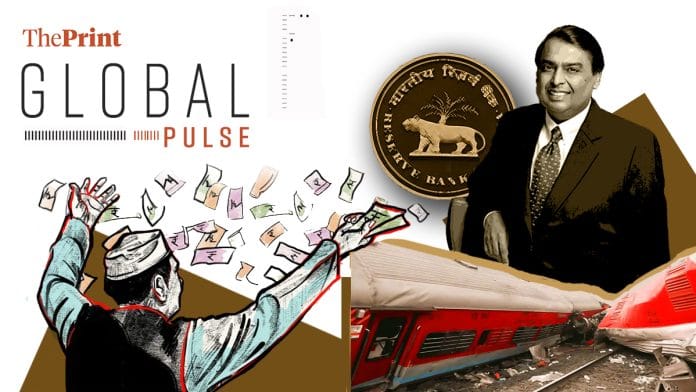New Delhi: The Economist has just caught on to the fact that Indian politicians are “obsessed with doling out cash”. Cash transfers and handouts are now seemingly inseparable from Indian politics.
In a story on handouts, The Economist writes about how the AAP and BJP were recently trying to outdo each other by unveiling their own cash transfer programmes for women in the run up to the Delhi elections. Besides Delhi, 11 other states implement such direct benefit transfers (DBTs) for women—all together reaching 134 million women across India. The total cost is Rs 2 trillion, almost 0.6 percent of India’s GDP.
“Cash transfers are not limited to women,” the story says. “Nor are freebies limited to humans. In the western state of Maharashtra, cows in public shelters are eligible for a 50-rupee-a-day subsidy.”
Women and cows are both at the forefront of most political parties’ minds. And “if votes are the measure, recent elections suggest that largesse is rewarded”, the story observes.
“Such programmes are an especially potent political tool because ruling parties can now connect directly with voters in a way they could not before,” the story continues—because of Aadhaar. “Crucially, these transfers also make it easier for political leaders to claim credit for their munificence because, unlike other programmes, their implementation does not require middlemen.”
And the strategy tends to work.
But the real question is whether the welfare model actually improves lives: it certainly boosts consumption and household spending, but doesn’t have the same impact on education and health—DBTs for education don’t seem to improve how well children do at school. Plus, some economists say that cash transfers actually hurt development by eating into the budget of other programmes.
“The biggest concern with freebies is what they mean for the role of the Indian state,” The Economist writes. “For instance, grand schemes appear to be in the works ahead of an election later this year in Bihar, India’s poorest state. One day, India’s voters, taxpayers especially, may demand better from their politicians. Just 2% of Indians, mainly members of the urban middle class, pay income tax. They are becoming noticeably frustrated about bearing the burden of the state’s generosity.”
The New York Times reports on the recent railway accident in Maharashtra, when at least 12 people were killed after they stepped off a train and were hit by another one while still on the tracks.
The passengers were aboard the train when word spread of a fire onboard. Panic ensued, and some people decided to step off the train when they were hit by another train on the adjoining track.
“The accident raised more questions around the safety of train travel in India, where millions of people depend on a vast but accident-prone railway network for transport, especially in rural areas,” the NYT reports. “The government has invested heavily in rail safety and launched a series of high-tech initiatives, although accidents continue.”
It lists some of the recent deadly train accidents including Odisha in 2023 and Tripura in 2024. Most of the people who died were migrants travelling to Mumbai to find work.
The reality of the economic downturn is unavoidable. The Financial Times reports that bank sector earnings have been badly dented, and that analysts expect bad debts and credit costs to rise further this year. Across the industry, FT reports, there’s “genuine concern that credit growth will drop to single digits.”
“The RBI, which launched its crackdown on unsecured lending after millions of Indian households loaded up on easily available credit, said in its financial stability report at the end of December that its measures to curb risky lending were ‘fructifying’,” FT reports, before adding that annual retail lending growth has nearly halved between September 2023 and September 2024.
Concerns about slowing credit have also made investors wary, even though some large lenders like Kotak Mahindra Bank have reported more robust earnings.
“The pressures on the industry’s loan book come as India’s banking sector also struggles with tight liquidity, with the RBI ramping up dollar sales to defend the country’s currency,” FT writes.
It’s not all doom and gloom though. Bloomberg reports that Reliance is building “what may become the world’s biggest data center by capacity in India.”
Reliance is buying Nvidia Corp’s AI semiconductors to set up a data center in Jamnagar that will have a total capacity of three gigawatts, making it “far bigger than any data center now operating.” Jamnagar is already the hub of Reliance’s refining and petrochemicals complex, which is the world’s largest.
With this move, Mukesh Ambani is joining a slew of tech companies like Microsoft, Amazon, and Alphabet in pouring billions of dollars into data centers to scale up and deliver AI capabilities to customers worldwide.
“Still, Ambani’s project, if it goes ahead as envisioned, stands out for its sheer size. The largest data centers operating now are less than 1 gigawatt, according to data provided by market intelligence firm DC Byte, which would make his several times larger than what’s on the market,” Bloomberg reports.
Data center capacity is measured in megawatts of electricity that the site can feed into servers, to cool systems and other equipment. And the larger the number, the higher the volume of operations it can support.
“Ambani built his reputation with aggressive business tactics, including a ruthless rush into the wireless business that sent prices plummeting and put several rivals out of business. His playbook seems similar in AI and he has said he will offer rock-bottom rates for what’s known as inferencing, or operating models like the ones that power ChatGPT,” Bloomberg reports.
It’s not yet clear how much Ambani is paying for this project. It could cost anywhere between $20 billion and $30 billion, Bloomberg estimates, and Reliance’s balance sheet currently has around $26 billion.






